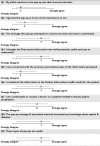An electronic prompt in dispensing software to promote clinical interventions by community pharmacists: a randomized controlled trial
- PMID: 17764471
- PMCID: PMC2291238
- DOI: 10.1111/j.1365-2125.2007.03012.x
An electronic prompt in dispensing software to promote clinical interventions by community pharmacists: a randomized controlled trial
Abstract
What is already known about this subject. Computerized prompts and reminders have been shown to be effective in changing the behaviour of health professionals in a variety of settings. There is little literature describing or evaluating electronic decision-support for pharmacists. What this study adds. An electronic prompt in dispensing software for a targeted clinical intervention has a significant effect on pharmacists' behaviour. A markedly increased rate of recording and performing the targeted clinical intervention was found. The effect of the prompt reduces markedly once the prompt is deactivated.
Aim: To evaluate the effect of an electronic prompt in dispensing software on the frequency of clinical interventions recorded by community pharmacists.
Method: An electronic decision-support prompt identifying patients for a targeted proactive clinical intervention was developed and implemented. Each time an oral antidiabetic agent was dispensed, a prompt was displayed reminding pharmacists to discuss the suitability of aspirin therapy in eligible patients with diabetes. The prompt was randomly assigned to 31 of 52 metropolitan pharmacies in Melbourne (Australia) for 6 weeks, with the remaining pharmacies as controls.
Results: One hundred and fifty pharmacists in 52 pharmacies recorded a total of 2396 clinical interventions at an intervention rate of 0.92 interventions per 100 patients [95% confidence interval (CI) 0.58, 1.23]. Pharmacists recorded a total of 201 target interventions related to aspirin therapy in diabetes at an intervention rate of 2.55 interventions per 100 diabetic patients (95% CI 0.85, 4.24). All of the targeted clinical interventions were recorded in the prompt arm; no targeted interventions were recorded in the control group. The effect of the prompt decreased over the study period and was not maintained after prompt deactivation.
Conclusion: An electronic prompt significantly increased pharmacists' recording of the targeted clinical intervention in diabetic patients. An electronic decision-support prompt has significant potential to promote community pharmacists' contribution to the quality use of medicines.
Figures




References
-
- Calabretto J-P, Warren J, Bird L. Pharmacy decision support: where is it? A systematic literature review. Int J Pharm Pract. 2005;13:157–64.
-
- Sacchetti A, Sacchetti C, Carraccio C, Gerardi M. The potential for errors in children with special health care needs. Acad Emerg Med. 2000;7:1330–3. - PubMed
-
- Garg AX, Adhikari NK, McDonald H, Rosas-Arellano MP, Devereaux PJ, Beyene J, Sam J, Haynes RB. Effects of computerized clinical decision support systems on practitioner performance and patient outcomes: a systematic review. JAMA. 2005;293:1223–38. - PubMed
Publication types
MeSH terms
LinkOut - more resources
Full Text Sources

